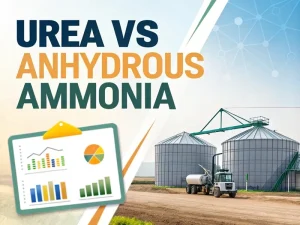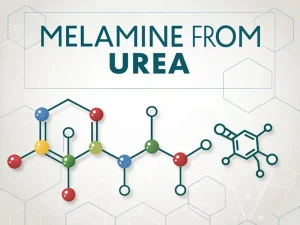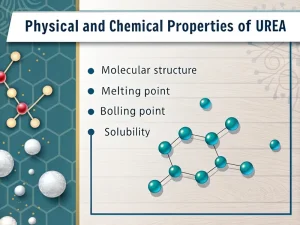
Urea VS Anhydrous Ammonia
Tech Blog urea vs anhydrous ammonia Nitrogen is the “lifeline” of crop growth, directly affecting leaf development, photosynthetic efficiency, and yield potential. For global farmers,


Urea is appropriate for every crop and all types of soil. Urea is ideal for base and follow-up fertilizer and can be applied to dry and wet fields. Because urea in the soil transformation can accumulate a large number of ammonium ions, will lead to a pH rise of 2-3 units, coupled with urea itself containing a certain amount of diuretics, the concentration of 500 ppm, it will be on the young roots and shoots of the crop to inhibit the role of urea should not be used as seed fertilizer.
Uses of urea fertilizer in agriculture, urea is an organic nitrogen fertilizer hydrolyzed into ammonium carbonate or bicarbonate through soil urease to be absorbed by the crop. Therefore, urea should be applied 4 to 8 days before the fertilizer demand period of the crop.
Urea, in the transformation before the molecular state, can not be absorbed by the soil and should be prevented from water loss; transformation of the formation of ammonia is also easy to volatilize, so urea should also be deeply applied to cover the soil.
Soil conversion into the soil in a small part of the molecular state dissolved in the soil solution, through the role of hydrogen bonding by the soil adsorption, most of the other urease under the action of hydrolysis into ammonium carbonate, which in turn generates carbonic acid and ammonium hydroxide. Then, plants can absorb ammonium ions and adsorbed by soil colloids. Plants can also absorb bicarbonate ions, so urea does not leave any harmful components after being applied to the soil.
In addition, diarrhea from urea can also be decomposed into ammonia and carbonic acid under urease. Urea conversion in the soil by the soil PH value, temperature and moisture in the soil is a neutral reaction; the higher the soil temperature when the humidity is appropriate, the faster the conversion; when the soil temperature is ten ℃ when the urea is completely converted to ammonium nitrogen need 7-10 days when 20 ℃ need 4-5 days when 30 ℃ need 2-3 days can be.
Urea hydrolyzed to ammonium nitrogen, the surface application will cause ammonia volatilization, especially on alkaline or alkaline soil is more serious, so in the application of urea should be applied to deep mulch, and paddy fields should be applied deep to the reduction layer.)
Regulate the amount of flowers
To overcome the apple land size of the year, in the event of a small year, in the 5-6 weeks after the flower (apple flower bud differentiation of the critical period, the new growth is slow or stop, leaf nitrogen content is a downward trend) foliar spraying 0.5% urea aqueous solution, sprayed twice, can improve leaf nitrogen, accelerate the growth of new growth inhibition of bud differentiation, so that the amount of flowers suitable for a significant year.
Thinning flowers and fruits
The peach tree’s flower organ is more sensitive to urea. Therefore, the foreign use of urea on peach and nectarine flower and fruit thinning test, the results show that peach and nectarine flower thinning, the need for a more significant concentration (7.4%) to show a good effect, the most suitable concentration of 8% -12%, sprayed within 1-2 weeks after the flowers and fruits, that is, the purpose of flower and fruit thinning can be achieved.
However, the response of different land conditions, periods, and varieties needs further testing.
Rice seed production
In hybrid rice seed production technology, to improve the heterosis rate of the parents to increase the amount of hybrid rice seed production or sterile line breeding, generally use gibberellin to spray the mother to reduce the degree of the mother’s package neck or make it wholly withdrawn; or spray the parents to regulate the growth of the two, to synchronize their flowering period.
As gibberellin is expensive, the cost of seed production with it is high. People experiment with urea instead of gibberellin, using 1.5%-2% urea at the peak period of pregnancy and the beginning of the spike (20% of the spike); the seed multiplication effect is similar to gibberellin and will not increase the height of the plant.
Pest control
Use urea, washing powder, and water 4:1:400 parts, stirring and mixing; it can prevent aphids, red spiders, cabbage greenflies and other pests on fruit trees, vegetables, and cotton, with a killing effect of more than 90%.
Urea Iron Fertilizer
Urea in the form of complexes and Fe2+ form chelated iron. This organic iron fertilizer is low-cost and has a good effect on preventing iron deficiency and greening. In addition to the foliar spray of 0.3% ferrous sulphate when adding 0.3% urea, the impact of control of greening is better than the single spray of 0.3% ferrous sulphate.
Feed additives:
Human food resources and protein shortages have also caused significant problems in the feed industry. The industry is actively looking for new protein sources and expanding to nitrogen sources other than protein, such as urea, which has a high nitrogen content.
In 1897, Waesk et al. proposed the idea that ruminants can convert non-protein nitrogen into bacterial proteins, and in 1949, C. J. Watson et al. fed sheep N15-labeled urea capsules, and N15-containing proteins were detected in their blood, liver, and kidneys four days later. This confirmed that ruminants can utilize non-protein nitrogen.
The same year, J. K. Looli et al. fed sheep urea as the sole nitrogen source. They found that the sheep had a positive nitrogen balance, indicating that the microorganisms in the rumen of sheep could synthesize the ten essential amino acids required for their growth using urea. Since then, urea and urea compounds have become feed additives for ruminants.
As an essential nitrogen fertilizer, Urea is widely used in agricultural production. It has the advantages of high nitrogen content, easy transportation and storage, and low price. It can also be used as a microbial agent to improve soil quality, slow down soil degradation, and maintain the balance of the agricultural ecological environment. Therefore, the application of Urea in agricultural production is essential.

Tech Blog urea vs anhydrous ammonia Nitrogen is the “lifeline” of crop growth, directly affecting leaf development, photosynthetic efficiency, and yield potential. For global farmers,

Tech Blog melamine from urea Melamine is well-known for its wide range of applications, but its raw material for production is surprisingly urea. For manufacturers,

Tech Blog physical and chemical properties of urea Urea, with the chemical formula CO(NH2)2, is a simple organic compound that plays a central role in

JINGJIANG MELAMINE POWDER
© JINJIANG MELAMINE